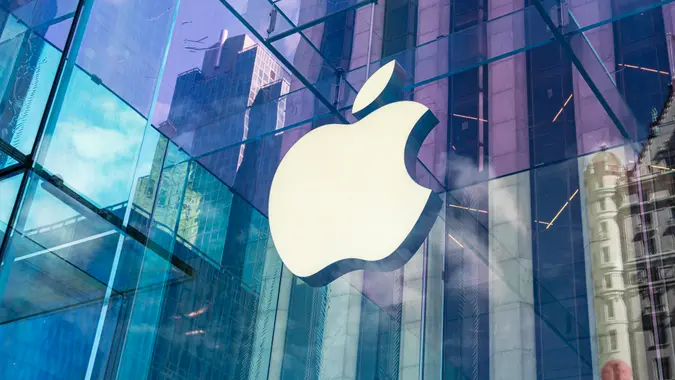Gap Stock: Pros and Cons of ‘Buying the Dip’ Amid Trump Tariff Drama

Commitment to Our Readers
GOBankingRates' editorial team is committed to bringing you unbiased reviews and information. We use data-driven methodologies to evaluate financial products and services - our reviews and ratings are not influenced by advertisers. You can read more about our editorial guidelines and our products and services review methodology.

20 Years
Helping You Live Richer

Reviewed
by Experts

Trusted by
Millions of Readers
In the wake of the President Donald Trump’s announcement of “Liberation Day” tariffs, the stock market tumbled. And that included Gap Inc. (GAP) and stocks of other retail companies that rely heavily on overseas manufacturing.
Investors who are considering taking advantage of this decline may well be wondering whether now is the right time to “buy the dip” in the stock or whether caution should prevail in light of the ongoing tariff battle.
The Impact of Trump’s Tariffs on Gap
The reciprocal tariffs sent shockwaves through U.S. retail stocks, though the Trump administration has since announced a pause on most reciprocal tariffs. Still, companies like Gap, which depend on international manufacturing, are feeling the effects.
For Gap, which manufactures a significant portion of its apparel in countries like China, Vietnam and Bangladesh, the immediate impact of the new tariffs was a sharp decline in its stock price. As of April 17, Gap stock is down almost 23% for the year.
Historical Context and Current Sentiment
To assess whether buying the dip in Gap stock is a sound decision, it’s essential to look at both historical performance and the current economic climate. Over the years, Gap has weathered numerous challenges, from changing consumer preferences to fluctuations in global trade policies.
In past instances of market turbulence, Gap’s stock has typically rebounded after initial declines. This historical pattern could indicate that the company could once again recover from the current downturn.
However, the sentiment surrounding Gap’s future is may be more mixed this time around. While Gap’s brand strength and global presence could help it navigate through these turbulent waters, the current geopolitical uncertainty adds a layer of risk. The tariffs, which target a wide array of goods, could have a longer-lasting impact on the company’s profit margins. Additionally, consumer demand for affordable clothing may be affected if prices rise as a result of the tariffs.
Despite these risks, some experts maintain that Gap is well positioned to adapt. The company has made efforts in recent years to streamline its operations and diversify its supplier base. In fact, according to Fortune, Gap CEO Richard Dickson recently spoke at the Shoptalk retail industry conference. “Big credit goes to our supply chains. We’ve been working on diversifying our manufacturer footprint for quite some time. Less than 10% of our product is coming out of China,” he said.
These moves may help Gap, but the tariffs affect other countries too.
Is ‘Buying the Dip’ the Right Move?
Some investors may see the recent drop in price as an opportunity to acquire shares at a bargain, particularly for those with a long-term investment strategy. The rationale here is that, like other retail giants, Gap has a history of bouncing back after periods of decline. For those who believe the stock market will recover and that Gap’s operational adjustments will eventually pay off, now might be the time to buy.
But for those considering a short-term investment, the risk of further declines may outweigh the potential rewards. If tariffs continue to escalate, or if consumer sentiment falters, Gap’s stock could take additional hits before it stabilizes. As such, some may recommend waiting until the effects of the tariffs are fully understood before making a move.
“There’s a lot of risk involved in buying Gap stock right now. There is certainly the possibility that the stock will rebound and investors will see pleasing returns. However, with so much financial uncertainty, consumers buy necessities, not clothes that may or may not have a rebounding cool factor. So, if Gap stock rebounds, it’s probably going to lag behind other stocks that are currently trending lower,” said Melanie Musson, a finance expert with Clearsurance.
Due to the continuing market volatility, it may be better to wait. “Since so many stocks are experiencing a dip, there are better options. Skip Gap and try for a different dip that has a higher probability of rebounding,” she said.
Weighing the Risks and Rewards of Buying Gap Stock
The recent drop in Gap’s stock price has sparked renewed debate about whether now is the right time to “buy the dip.” While some may see it as an opportunity to acquire shares at a discounted price, others urge caution, pointing to the uncertainties created by the tariffs and their potential long-term effects on Gap’s business.
Ultimately, the decision to buy or hold should be based on individual investment goals, risk tolerance and the willingness to weather potential market fluctuations.
More From GOBankingRates
 Written by
Written by  Edited by
Edited by 

























